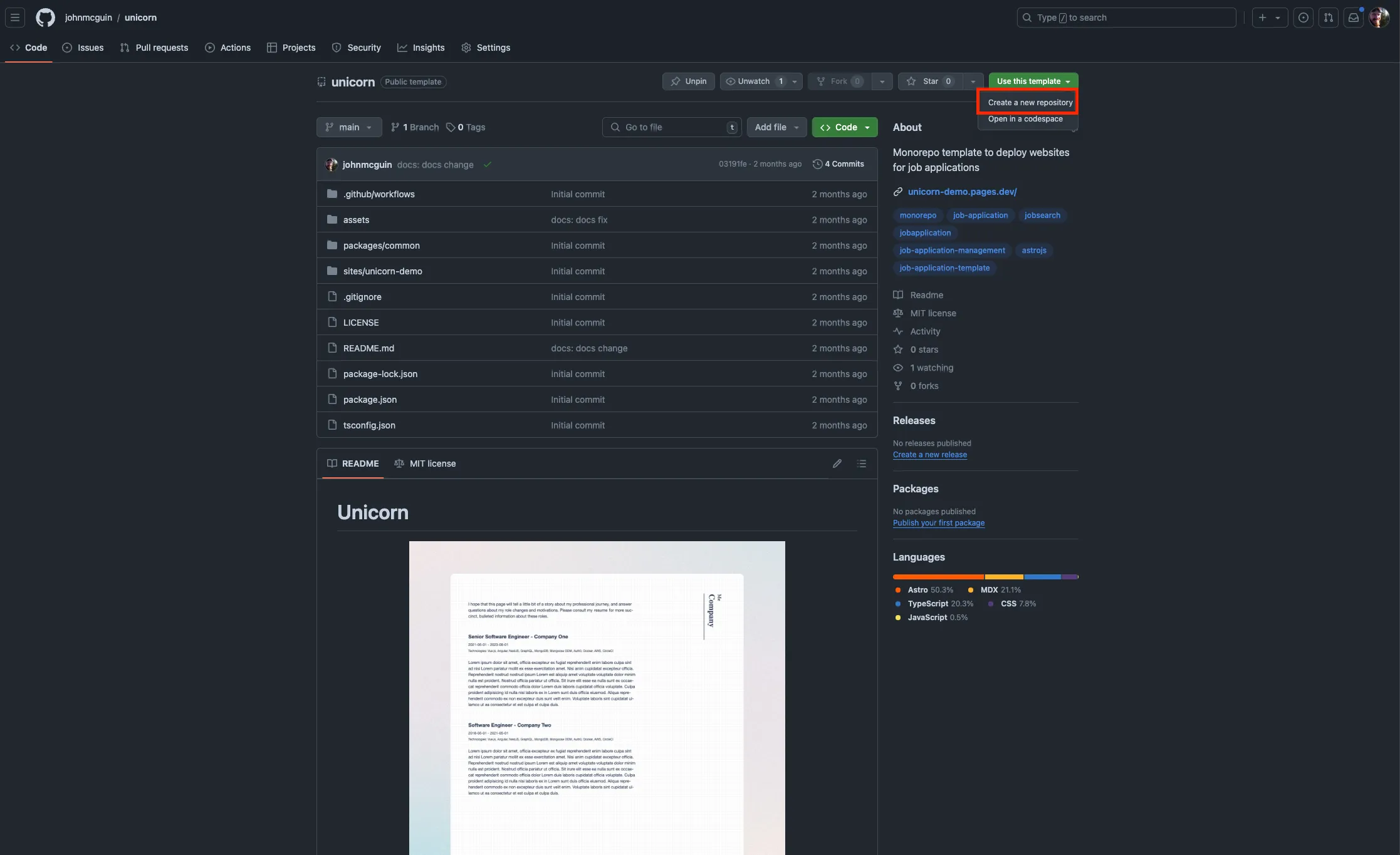Introducing Unicorn, a monorepo template built on GitHub Actions and Cloudflare to help you stand out in your job applications by deploying a static site for each job application.
Create repo
First, you’ll need to clone the template repository to your own, working repository.

Clone into repo
Next, clone your new repository to your local dev machine and install dependencies.
npm installCreate a site
The easiest way to create a site is to use the npm run new command. This is the basis of creating
a new site based on the template site that lives at sites/template. You can consult the help docs
by running npm run new -- --help. Take a minute to read the output.
$ npm run new -- --help
> unicorn@0.1.0 new
> scripts/new_site.mjs new --help
Usage: Unicorn CLI new [options]
Create a new website
Options:
-d, --dir <name> name of the directory
-j, --job <title> job title you are applying for
-c, --company <name> name of the company. This will be used in website copy.
-h, --help display help for commandThe options themselves should be fairly straightforward. What is happening behind the scenes is that
the directory flag will make a copy of the template site and create a new site at
sites/<directory>. The job and company flags will be used for text substitions throughout the
website’s copy. This should inform the copy that you write for your own version of the template
site. The template site is meant to be customized! It is recommended to write the template site out
to minimize the amount of work required after running the script. When customizing the template,
there is an assumption that the script makes, which is that the template is substituting all
instaces of the string “Company” with the value passed into the --company flag. It replaces all
instances of the string “Job Title” with the --job flag. Write your template accordingly!
Alternatively, you can customize the script to suit your exact needs. This is not meant to be a
silver bullet but more of a starting off point for your own personal automations to this process.
When you are done with the npm run new script, you have a new site! The output states how exactly
to run your new site. The only manual steps that you have are to:
- Create a Cloudflare Pages project
- Add an entry to
sites.jsonwhere the key is the directory name and its value is the name of the Cloudlfare Pages project. - Customize the site (resume, copy, etc) to the specific job application.
- Push and monitor the action to make sure the deployment was successful. If everything went right, you should now have a new site live.
Deployment
You’ve developed your website and are ready to deploy it. First, either create or login to your Cloudflare account. In your Cloudflare account, navigate to “Profile” -> “API Tokens” -> “Create Token”. Under the “Custom token” section, click to create a custom token. Give the token a name and the edit permission to Cloudflare Pages. Copy this token and navigate to your GitHub repository. Add a GitHub secret named ‘DEPLOY_TOKEN’, pasting the token from the previous step as the value. Add another secret called ‘CLOUDFLARE_ACCOUNT_ID’. Obtain the value for this from the Cloudflare dashboard. Navigate to the “Workers and Pages” section in your Cloudflare account. You should be able to copy the account id from the sidebar of this web page. The workflow will use these secrets to deploy your websites to your Cloudflare account.
While in the Cloudflare dashboard, create your first site. Navigate to “Workers and Pages”. Select “create application”. Select “Pages” tab. Select “Create using direct upload”. Select “Upload assets”, although we will be skipping the actual upload of assets (the GH action workflow will do this for us, we just need to create the pages “project” at this point). Give the project a name, and select “Create project” without uploading assets. Take note of the project name you provided. Update the GitHub action’s matrix property with this value. You should update the ‘project’ key.
At this point, everything should be setup for a deployment to succeed. To test this out, push your working repository to the GitHub remote and watch the action run.
DNS
DNS is out of scope for this post. For my own job applications, I use Cloudflare name servers and deploy each website as a subdomain to a personal TLD, which works quite well.
If you have any issues following this post, please open an issue on GitHub.